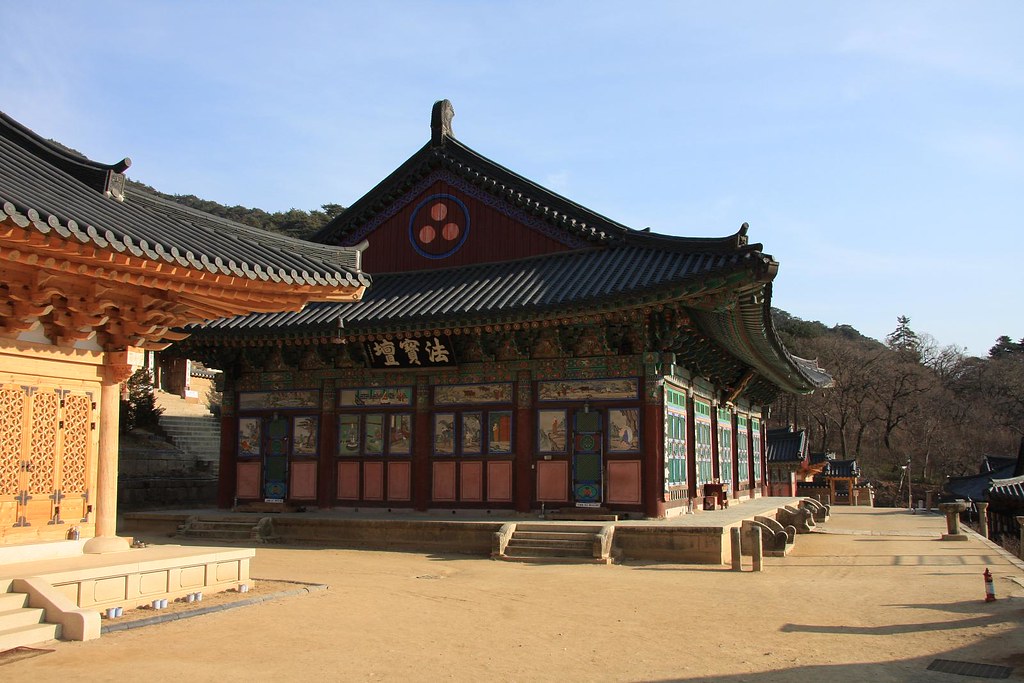Buddhism
is a major world religion and philosophy founded in northeastern India
in the 5th century BC. It is based on the teachings of Siddhartha
Gautama, commonly known as “The Buddha”, who was born in what is today
Nepal. Buddhism takes as its goal the escape from suffering and from
the cycle of rebirth: the attainment of nirvana. There are between 230
million and 500 million Buddhists worldwide. An overview of the most famous Buddhist temples in the world.
10Haeinsa Temple

flickr/erinc salor
Haeinsa (Temple of Reflection on a Smooth Sea) is one of the most
important Buddhist temples in South Korea. The temple was first built in
802 and rebuilt in the 19th century after Haiensa was burned down in a
fire in 1817. The temple’s greatest treasure however, a complete copy of
the Buddhist scriptures (he Tripitaka Koreana) written on 81,258
woodblocks, survived the fire.
9Wat Arun

Situated on the Thonburi side of the Chao Phraya River , Wat Arun
(“Temple of Dawn”) is one of the oldest and best known landmarks in
Bangkok, Thailand. The temple is an architectural representation of
Mount Meru, the center of the universe in Buddhist cosmology. Despite
it’s name, the best views of Wat Arun are in the evening with the sun
setting behind it.
8Pha That Luang

flickr/A_E_P
Located in Vientiane, Pha That Luang (“Great Stupa in Lao”) is one of
the most important monument in Laos. The stupa has several terraces
with each level representing a different stage of Buddhist
enlightenment. The lowest level represents the material world; the
highest level represents the world of nothingness. Pha That Luang was
built in the 16th century on the ruins of an earlier Khmer temple. The
temple was destroyed by a Siamese invasion in 1828, then later
reconstructed by the French in 1931.
7Jokhang

The Jokhang Temple in Lhasa is the most important sacred site in
Tibetan Buddhism attracting thousands of pilgrims each year. The temple
was constructed by King Songtsän Gampo in the 7th century. The Mongols
sacked the Jokhang temple several times but the building survived. Today
the temple complex covers an area of about 25,000 square meters.
6Todaiji Temple

flickr/roybuloy
Todaiji (“Great Eastern Temple”) in Nara is one of the most historically significant and famous Buddhist temples in Japan.
The temple was built in the 8th century by Emperor Shomu as the head
temple of all provincial Buddhist temples of Japan. Today little remains
of the original buildings of Todaiji. The Daibutsuden (“Great Buddha
Hall”), dates for the most part from 1709. It houses one of the largest
Budha statues in Japan and is the worlds largest wooden building, even
though it is only two-thirds the size of the original structure.
5Boudhanath

Located in a suburb of Kathmandu, Boudhanath is one of the largest
stupas in the world. It is the center of Tibetan Buddhism in Nepal and
many refugees from Tibet have settled here in the last few decades. It
is probably best known for the Buddha eyes that are featured on all four
sides of the tower. The present stupa is said to date from the 14th
century, after the previous one was destroyed by Mughal invaders.
4Mahabodhi Temple

The Mahabodhi (Great Enlightenment) Temple is a Buddhist stupa
located in Bodh Gaya, India. The main complex contains a descendant of
the original Bodhi Tree under which Gautama Buddha gained enlightenment
and is the most sacred place in Buddhism. About 250 years after the
Buddha attained Enlightenment, Emperor Asoka built a temple at the spot.
The present temple dates from the 5th-6th century.
3Shwedagon Pagoda

The Shwedagon Pagoda (or Golden Pagoda) in Yangon, is the holiest
Buddhist shrine in Burma. The origins of Shwedagon are lost in antiquity
but it is estimated that the Pagoda was first built by the Mon during
the Bagan period, sometime between the 6th and 10th century AD. The
temple complex is full of glittering, colorful stupas but the center of
attention is the 99 meter high (326 feet) high main stupa that is
completely covered in gold.
2Bagan

Bagan, also spelled Pagan, on the banks of the Ayerwaddy River, is
home to the largest area of Buddhist temples, pagodas, stupas and ruins
in the world. It was the capital of several ancient kings of Burma who
built perhaps as many as 4,400 temples during the height of the kingdom
(between 1000 and 1200 AD). In 1287, the kingdom fell to the Mongols,
after refusing to pay tribute to Kublai Khan and Bagan quickly declined
as a political center, but continued to flourish as a place of Buddhist
scholarship.
1Borobudur

photo/Kenyon College
Located on the Indonesian island of Java, 40 km (25 miles) northwest
of Yogyakarta, the Borobudur is the largest and most famous Buddhist
temple in the world. The Borobudur was built over a period of some 75
years in the 8th and 9th centuries by the kingdom of Sailendra, out of
an estimated 2 million blocks of stone. It was abandoned in the 14th
century for reasons that still remain a mystery and for centuries lay
hidden in the jungle under layers of volcanic ash.
Search Touropia


No comments :
Post a Comment